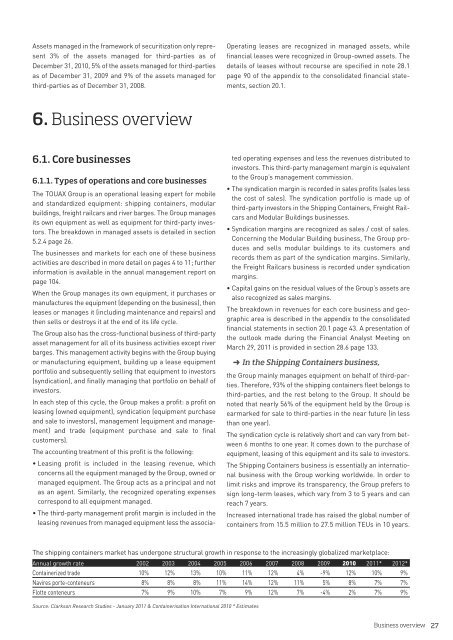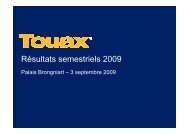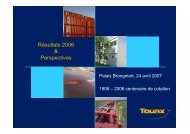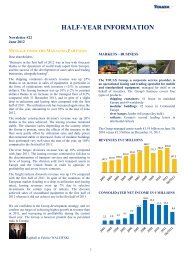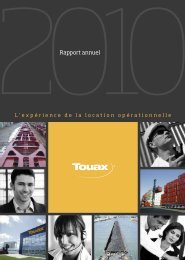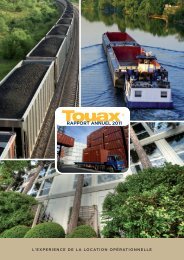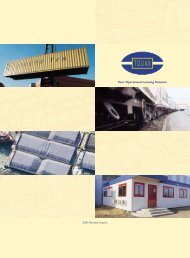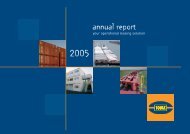2010 annual report - touax group
2010 annual report - touax group
2010 annual report - touax group
Create successful ePaper yourself
Turn your PDF publications into a flip-book with our unique Google optimized e-Paper software.
Assets managed in the framework of securitization only represent<br />
3% of the assets managed for third-parties as of<br />
December 31, <strong>2010</strong>, 5% of the assets managed for third-parties<br />
as of December 31, 2009 and 9% of the assets managed for<br />
third-parties as of December 31, 2008.<br />
Operating leases are recognized in managed assets, while<br />
financial leases were recognized in Group-owned assets. The<br />
details of leases without recourse are specified in note 28.1<br />
page 90 of the appendix to the consolidated financial statements,<br />
section 20.1.<br />
6. Business overview<br />
6.1. Core businesses<br />
6.1.1. Types of operations and core businesses<br />
The TOUAX Group is an operational leasing expert for mobile<br />
and standardized equipment: shipping containers, modular<br />
buildings, freight railcars and river barges. The Group manages<br />
its own equipment as well as equipment for third-party investors.<br />
The breakdown in managed assets is detailed in section<br />
5.2.4 page 26.<br />
The businesses and markets for each one of these business<br />
activities are described in more detail on pages 4 to 11; further<br />
information is available in the <strong>annual</strong> management <strong>report</strong> on<br />
page 104.<br />
When the Group manages its own equipment, it purchases or<br />
manufactures the equipment (depending on the business), then<br />
leases or manages it (including maintenance and repairs) and<br />
then sells or destroys it at the end of its life cycle.<br />
The Group also has the cross-functional business of third-party<br />
asset management for all of its business activities except river<br />
barges. This management activity begins with the Group buying<br />
or manufacturing equipment, building up a lease equipment<br />
portfolio and subsequently selling that equipment to investors<br />
(syndication), and finally managing that portfolio on behalf of<br />
investors.<br />
In each step of this cycle, the Group makes a profit: a profit on<br />
leasing (owned equipment), syndication (equipment purchase<br />
and sale to investors), management (equipment and management)<br />
and trade (equipment purchase and sale to final<br />
customers).<br />
The accounting treatment of this profit is the following:<br />
• Leasing profit is included in the leasing revenue, which<br />
concerns all the equipment managed by the Group, owned or<br />
managed equipment. The Group acts as a principal and not<br />
as an agent. Similarly, the recognized operating expenses<br />
correspond to all equipment managed.<br />
• The third-party management profit margin is included in the<br />
leasing revenues from managed equipment less the associated<br />
operating expenses and less the revenues distributed to<br />
investors. This third-party management margin is equivalent<br />
to the Group’s management commission.<br />
• The syndication margin is recorded in sales profits (sales less<br />
the cost of sales). The syndication portfolio is made up of<br />
third-party investors in the Shipping Containers, Freight Railcars<br />
and Modular Buildings businesses.<br />
• Syndication margins are recognized as sales / cost of sales.<br />
Concerning the Modular Building business, The Group produces<br />
and sells modular buildings to its customers and<br />
records them as part of the syndication margins. Similarly,<br />
the Freight Railcars business is recorded under syndication<br />
margins.<br />
• Capital gains on the residual values of the Group’s assets are<br />
also recognized as sales margins.<br />
The breakdown in revenues for each core business and geographic<br />
area is described in the appendix to the consolidated<br />
financial statements in section 20.1 page 43. A presentation of<br />
the outlook made during the Financial Analyst Meeting on<br />
March 29, 2011 is provided in section 28.6 page 133.<br />
➜ In the Shipping Containers business,<br />
the Group mainly manages equipment on behalf of third-parties.<br />
Therefore, 93% of the shipping containers fleet belongs to<br />
third-parties, and the rest belong to the Group. It should be<br />
noted that nearly 56% of the equipment held by the Group is<br />
earmarked for sale to third-parties in the near future (in less<br />
than one year).<br />
The syndication cycle is relatively short and can vary from between<br />
6 months to one year. It comes down to the purchase of<br />
equipment, leasing of this equipment and its sale to investors.<br />
The Shipping Containers business is essentially an international<br />
business with the Group working worldwide. In order to<br />
limit risks and improve its transparency, the Group prefers to<br />
sign long-term leases, which vary from 3 to 5 years and can<br />
reach 7 years.<br />
Increased international trade has raised the global number of<br />
containers from 15.5 million to 27.5 million TEUs in 10 years.<br />
The shipping containers market has undergone structural growth in response to the increasingly globalized marketplace:<br />
Annual growth rate 2002 2003 2004 2005 2006 2007 2008 2009 <strong>2010</strong> 2011* 2012*<br />
Containerized trade 10% 12% 13% 10% 11% 12% 4% -9% 12% 10% 9%<br />
Navires porte-conteneurs 8% 8% 8% 11% 14% 12% 11% 5% 8% 7% 7%<br />
Flotte conteneurs 7% 9% 10% 7% 9% 12% 7% -4% 2% 7% 9%<br />
Source: Clarkson Research Studies - January 2011 & Containerisation International <strong>2010</strong> * Estimates<br />
Business overview<br />
27


